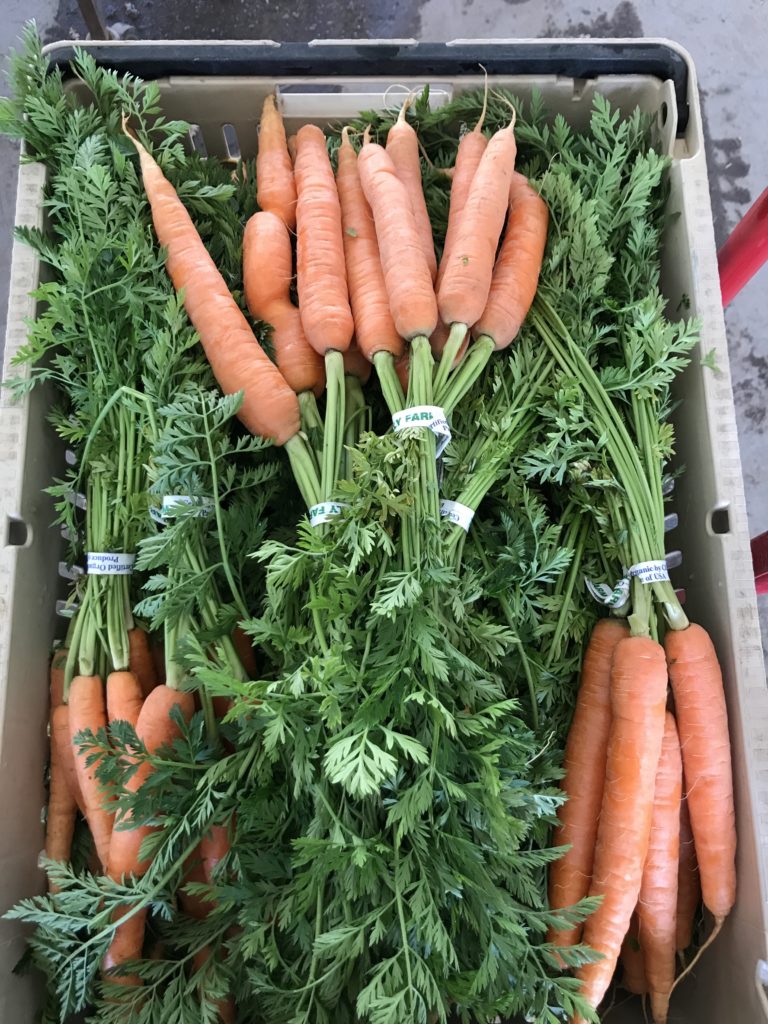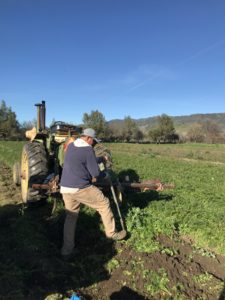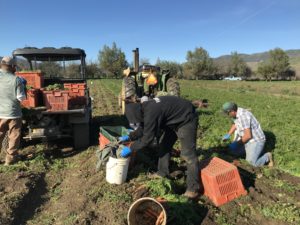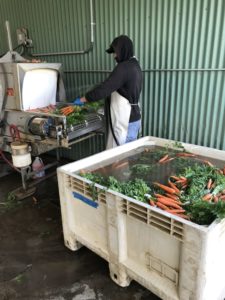
As you’ve realized by now, we grow great carrots. Perhaps the greatest carrots. They’ve long been one of my favorite things that we grow, ever since my first Full Belly carrot in my family’s CSA box, and I eagerly await when they’re ready to harvest each year. If you’ve ever wondered the process of growing our amazing carrots, read on!
First, there’s the variety. The average grocery store carrot is an Imperator-type, which are large, a bit fibrous, and have a shape that makes them stack well in grocery displays. We grow Nantes, which are sweeter, have a cylindrical (instead of tapered) shape, and more brittle, crunchy texture.
Then there’s buying and planting the seeds. Carrot seeds are very small, like caraway seeds, and are sewn directly in the soil. We do this with a precision planter attached to a tractor. It picks up one seed at a time with a vacuum and then drops it into the soil. It struggles with the non-spherical shape and lightness of carrot seeds so we buy pelleted seeds, which means the seed is surrounded by a clay coating that makes them round (think of a malted milk ball or a yogurt-covered raisin), enabling the planter to pick up one seed at a time. We buy pelleted seeds for other crops too, like lettuce and beets. Using a precision planter means we get the seeds to at the spacing we want, which is important so that we can avoid thinning the carrots which takes a lot of extra time and energy, which we’d rather put towards other tasks.
We plant three rows of carrots per bed and each row has 2 bands of carrots. Within each row and band, there’s a carrot every inch or so. We’ll plant 5 acres of carrots each year, which requires about 5 million carrot seeds!
The first carrots are seeded by mid-August when it’s really hot. Carrots want soil temperatures in the mid 70s to germinate, so it’s a challenging time to plant, but it needs to happen then if we want carrots by the end of October. Once they’re in the ground, we water a little bit every day to keep the soil moist. We do many different plantings of carrots to have a constant supply of carrots from the end of October until the beginning of summer. After that, it gets too hot for ideal carrot growing and (again) we need to spend our time focusing on other crops. The last carrot seeds are going in the ground this week!
Right before the seeds germinate, if there are a lot of small weeds we will flame weed the rows to burn them off. Once the carrots germinate and have their first few leaves, we almost always need to come through and do some weeding by hand and then subsequent weeding is done by tractor on a regular basis until the carrots are established enough to outcompete the weeds.
Carrots take roughly 70 days to grow, but there is a lot of variability based on the time of year. During the colder months when there’s little sunlight, they grow very slowly, and the carrots we plant this week may not germinate for several weeks, depending on the temperature. But once they’re going, they can grow quickly, doubling in size every week. And if you’ve ever seen a non-straight, funny looking carrot, the odd shape comes from the carrot bumping into something (like a rock) while growing. If carrots are grown in sandy soil, which we don’t have, they’re more likely to be straight.


Eventually the carrots will be ready to harvest. Since we don’t have sandy soil, it’s impossible to pull them out of the ground without some sort of tool. If the ground is wet, we use digging forks, demonstrated in the photo on the left. If it’s dry enough, we use a tractor implement that runs a knife under the soil, just below the carrots, to lift and break up the soil so that carrots can be pulled out by hand. While still in the field, the carrots are sorted and bunched, yellow leaves are removed, and dirt clods are brushed off. When the carrots make it back to the shop, first they soak in water, then are put through our root washer. That’s how we get them so clean!



Not every carrot ends up in a bunch; some are bagged. These are the exact same carrots, just may have lost their greens in the harvesting process. If you get carrots without their greens at some point in the season, it doesn’t mean that they’re any less fresh or as tasty! Some of our bulk bags of carrots contain more of the funny-shaped ones, or ones with broken tips, but again, they’re just as good. The crispness that makes them so satisfying to eat means that they also can snap easily while getting them out of the ground. Many of the broken ones end up in our carrot tea cakes or carrot juice, or in some cases we share some with the animals too. We try to find every carrot a home since we spent a lot of time and effort to grow them.
And that’s the process. That’s how you grow an amazing, Full Belly carrot!
– Elaine Swiedler, CSA Manager (with lots of help and information from Andrew Brait)
